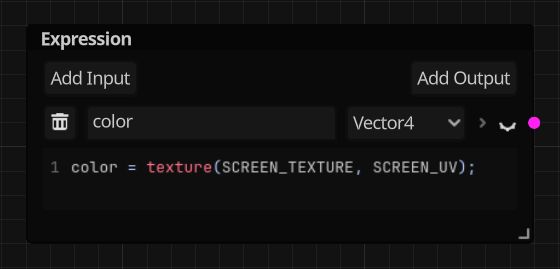Click here to skip to the instructions.
So Godot Engine has a really cool shader system, allowing you to do stuff like change the way lighting works in both 2D and 3D using nothing but shaders, and it additionally has a powerful VisualShader system. VisualShaders, for those who don’t know, are shaders that use a Shader Graph system instead of pure code. I’m not huge on node-based programming systems, so I usually elect to (poorly) write a shader myself, but I’m working on a game jam with a larger team than I ever have before right now, and they wanted to use the ShaderV addon because of how many cool things it has.
So I took the two shaders I’d written with code based on code from the plugin, and converted them to VisualShaders.
Or, I started to anyways. It ended up being harder than expected.
In Godot 4, the SCREEN_TEXTURE variable isn’t declared by default. Instead,
you need to write a single line of code to access the screen texture
(uniform sampler2D SCREEN_TEXTURE : hint_screen_texture;). This is fine in
code, but VisualShaders don’t have this hint type.
So how do you get it?
It’s actually simple but also hellish. I’m going to set it to a variable because that makes it reusable, but if you only need to use it once it’s easy enough to just plug the output directly into where it needs to go.
The Actual Tutorial Bit Finally
Step 1

Make a new GlobalExpression node in the graph and insert the following code:
uniform sampler2D SCREEN_TEXTURE : hint_screen_texture;
This gives us access to the screen texture using the SCREEN_TEXTURE variable.
Step 2

Make a new Expression node in the graph, give it an output parameter of type Vec4
(or Vec3 if you only want .rgb) and give it this code:
color = texture(SCREEN_TEXTURE, SCREEN_UV);
This gets the colour of the screen texture at the correct coordinates.
Step 3
 Access it as you need!
Access it as you need!
Anyways, hope that this helps you save time so you don’t spend an hour hacking at this like I did!